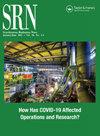Lattice Dynamics Signatures of Competing Orders in Unconventional Superconductors
Q3 Physics and Astronomy
引用次数: 1
Abstract
Introduction Unconventional superconductivity typically refers to a superconducting state that stems from an effective attractive interaction between electronic quasiparticles, which is not the canonical electron-phonon coupling (EPC) [1]. The latter has been the key ingredient in unveiling the Cooper pairing mechanism on which builds the conventional theory of superconductivity (or theory of conventional superconductivity) originally proposed by Bardeen, Cooper, and Schrieffer [2]. The large variety of unconventional superconducting materials indicates that there is probably no unified theory of unconventional superconductivity that could account for all phenomena encountered in these materials. Nevertheless, it appears empirically that unconventional superconductivity often emerges in the neighborhood of closely degenerate electronic phases, which coexist, sometimes compete, or are even intertwined with the superconducting state [3, 4]. Critical fluctuations associated with these other electronic phases are often suspected to play a decisive role in unconventional superconducting pairing, which has in turn motivated the development of experimental tools allowing us to probe materials of interest at energies and momenta matched to their intrinsic collective responses. As such, even though the EPC does not appear to be the primary driver of unconventional superconductivity, the coupling of electronic to lattice degrees of freedom has proven to be a sensitive probe of competing orders. Renormalization of the phonon spectra across electronic phase transitions is a particularly well-suited approach for these investigations. It has recently benefited a lot from the development of inelastic X-ray scattering (IXS) [5], which enables in particular the use of high pressures (in the tens of GPa range) as a “clean” way to drive a system across phase transitions. In this short topical review, we illustrate this by reporting three recent cases in which phonon spectroscopy has been particularly insightful in addressing the physics of competing orders in unconventional superconductors, namely the high-temperature superconducting cuprates, Fe-based superconductors, and their Ni-based cousins.非常规超导体中竞争序的晶格动力学特征
引言非常规超导通常是指源于电子准粒子之间有效吸引相互作用的超导状态,而不是典型的电子-声子耦合(EPC)[1]。后者是揭示库珀配对机制的关键因素,该机制建立了Bardeen、Cooper和Schrieffer[2]最初提出的传统超导理论(或传统超导理论)。非常规超导材料的种类繁多表明,可能没有统一的非常规超导理论来解释这些材料中遇到的所有现象。然而,从经验上看,非常规超导性通常出现在紧密简并的电子相附近,这些电子相与超导态共存、有时竞争,甚至交织在一起[3,4]。与这些其他电子相相关的临界波动通常被怀疑在非常规超导配对中起着决定性作用,这反过来又推动了实验工具的发展,使我们能够以与其固有集体反应相匹配的能量和动量探测感兴趣的材料。因此,尽管EPC似乎不是非常规超导的主要驱动因素,但电子与晶格自由度的耦合已被证明是竞争阶数的敏感探针。对电子相变中的声子光谱进行重整化是一种特别适合这些研究的方法。最近,它从非弹性X射线散射(IXS)[5]的发展中受益匪浅,特别是它能够使用高压(在数十GPa范围内)作为一种“干净”的方式来驱动系统跨越相变。在这篇简短的主题综述中,我们通过报道最近的三个案例来说明这一点,在这些案例中,声子光谱学在解决非常规超导体中竞争有序的物理问题方面特别有见地,即高温超导铜酸盐、铁基超导体及其镍基表亲。
本文章由计算机程序翻译,如有差异,请以英文原文为准。
求助全文
约1分钟内获得全文
求助全文
来源期刊

Synchrotron Radiation News
Physics and Astronomy-Nuclear and High Energy Physics
CiteScore
1.30
自引率
0.00%
发文量
46
 求助内容:
求助内容: 应助结果提醒方式:
应助结果提醒方式:


